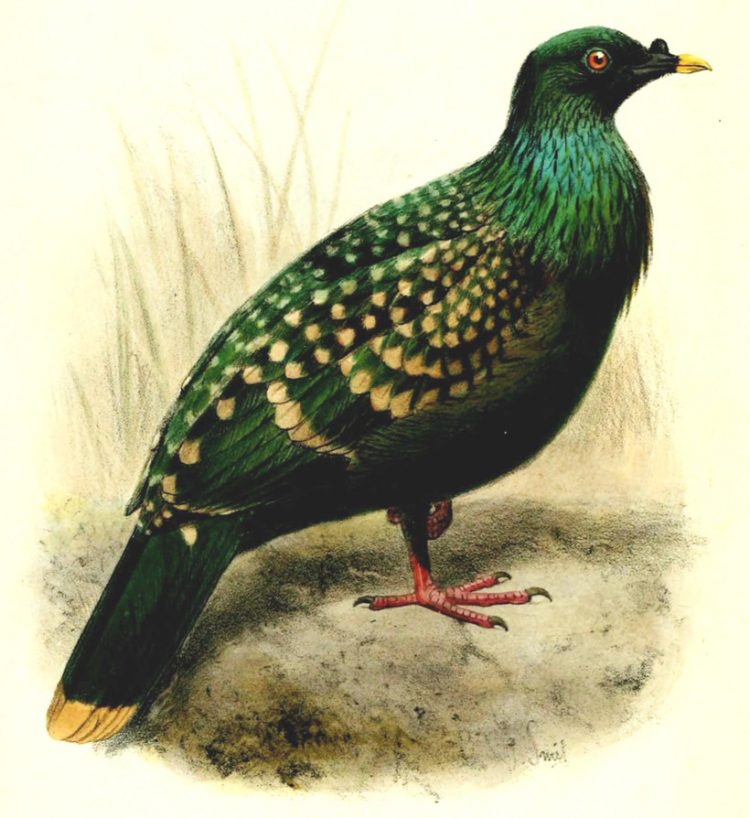Dodos and spotted green pigeons are descendants of an island hopping bird

Spotted Green Pigeon by Joseph Smit, bulleting of Liverpool Museums
The only known example of the spotted green pigeon is the Liverpool pigeon, which is currently in the World Museum, Liverpool. The only other known specimen has been lost, and there are no records of the bird in the wild. There is no record of where the pigeon was found, and it wasn't even known if the spotted green pigeon was a species, or just an unusual form of the Nicobar pigeon from around Indonesia.
The scientists took DNA from two feathers of the spotted green pigeon. Because of its age, the DNA was highly fragmented, so they focused in on three DNA 'mini barcodes' – small sections of DNA which are unique for most bird species. They looked at these sections of the pigeon's DNA, and compared it to other species.
This showed that the spotted green pigeon is indeed a separate species, showing a unique DNA barcode compared to other pigeons. The pigeon is genetically most closely related to the Nicobar pigeon and the dodo and Rodrigues solitaire, both extinct birds from islands near Madagascar.
The spotted green pigeon shows signs of a semi-terrestrial island lifestyle and the ability to fly. The closely related Nicobar pigeon shows similar habits and has a preference for travelling between small islands.
The scientists say this lifestyle, together with the relationship of both pigeons to the dodo and Rodrigues solitaire supports an evolutionary theory that the ancestors of these birds were 'island hoppers', moving between islands around India and Southeast Asia.
The birds that settled on particular islands then evolved into the individual species. The dodo's ancestor managed to hop as far as the island of Mauritius near Madagascar where it then lost the ability to fly.
Dr Tim Heupink, Griffith University Australia says: “This study improves our ability to identify novel species from historic remains, and also those that are not novel after all. Ultimately this will help us to measure and understand the extinction of local populations and entire species.”
Clemency Fisher, Curator of Vertebrate Zoology at the World Museum says: “We are very pleased that the extinct spotted green pigeon has its correct place in the world of birds after more than 230 years. Tim Heupink's groundbreaking genetic research, analysing small fragments of DNA from tiny pieces of feather, proves the spotted green pigeon is unique and a distant relation to the Nicobar pigeon, the Rodrigues solitaire and the dodo of Mauritius”.
Media Contact
Anna Perman
Media Officer
BioMed Central
T: +44 (0)20 3192 2429
E: Anna.Perman@biomedcentral.com
Notes to Editor
1. Research article
The mysterious Spotted Green Pigeon and its relation to the Dodo and its kindred.
Tim H Heupink, Hein van Grouw and David M Lambert
BMC Evolutionary Biology
Please name the journal in any story you write. If you are writing for the web, please link to the article. All articles are available free of charge, according to BioMed Central's open access policy.
2. The pigeon specimen will be on display in the Liverpool Museum for two weeks from Wednesday 16th July. There will be opportunity for filming and a interviews with Clemency Fisher at the museum on Wednesday 16th July, through a booked appointment.
3. Images are available in this Dropbox https://www.dropbox.com/sh/uh2l8bc3j7dtfvp/AAA_XzrtPdUk-O0MCsSJDhZ8a
4. BMC Evolutionary Biology is an open access, peer-reviewed journal that considers articles on all aspects of molecular and non-molecular evolution of all organisms, as well as phylogenetics and palaeontology.
5. BioMed Central is an STM (Science, Technology and Medicine) publisher which has pioneered the open access publishing model. All peer-reviewed research articles published by BioMed Central are made immediately and freely accessible online, and are licensed to allow redistribution and reuse. BioMed Central is part of Springer Science+Business Media, a leading global publisher in the STM sector.
6. From the sea to the stars, a visit to World Museum reveals millions of years of the Earth's history through thousands of exhibits and hands on activities. Find out how humans have created the world we inhabit, from Africa to the Americas, Asia and Europe. Look out for the Ancient Egypt gallery where our collection is amongst the finest in Europe, bringing this age old civilisation to life. Discover the wonders of the natural world in the Clore Natural History Centre, packed full of mounted and preserved specimens of all types of animals, as well as rocks, minerals, fossils and plants. The Aquarium is home to fish from Australia to Anglesey, while an array of creepy crawlies live in the Bug House. Then, blast off on a spectacular journey through space and time as the universe unfolds around you in the Planetarium.
Media Contact
All latest news from the category: Life Sciences and Chemistry
Articles and reports from the Life Sciences and chemistry area deal with applied and basic research into modern biology, chemistry and human medicine.
Valuable information can be found on a range of life sciences fields including bacteriology, biochemistry, bionics, bioinformatics, biophysics, biotechnology, genetics, geobotany, human biology, marine biology, microbiology, molecular biology, cellular biology, zoology, bioinorganic chemistry, microchemistry and environmental chemistry.
Newest articles

Dark energy ‘doesn’t exist’ so can’t be pushing ‘lumpy’ Universe apart
One of the biggest mysteries in science – dark energy – doesn’t actually exist, according to researchers looking to solve the riddle of how the Universe is expanding. For the…

Warming exacerbates oxygen depletion in the Baltic Sea
Rising water temperatures undermine nutrient reduction efforts. Eutrophication and rising water temperatures are taking an increasing toll on the Baltic Sea, leading to dangerous oxygen depletion in deeper water layers…

Time-resolved polarimetric electron microscopy reveals spin meron pair
New technique reveals complex spin structures at femtosecond timescales. Plasmons are collective oscillations of electrons in a solid and are important for a wide range of applications, such as sensing,…



